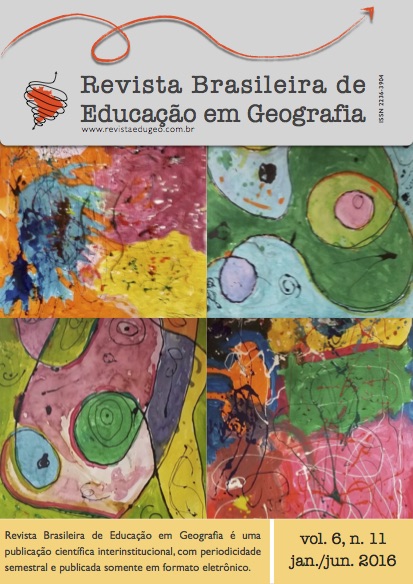GEOGRAFIA NA INFÂNCIA PARA ALUNOS COM DEFICIÊNCIA VISUAL: a utilização de uma maquete multissensorial para a aprendizagem do conceito de paisagem
Palavras-chave:
Deficiência Visual, Geografia, Infância, Paisagem Multissensorial.Resumo
O Ensino de Geografia para alunos com Deficiência Visual, precisa ser recontextualizado para que esses educandos possam construir seus conhecimentos através de experiências multissensoriais, nas quais os outros sentidos sejam utilizados. Repensar o Ensino de Geografia para alunos com Deficiência Visual no que tange ao conceito de paisagem, a partir de uma vivência sensorial, torna-se possível por meio da construção do conceito através de uma dimensão de texturas, aromas, sons e sabores, sendo necessário explorar o tato, o olfato, a audição e o paladar. Esse artigo tem como objetivo apresentar um material didático multissensorial (maquete) que representa uma paisagem que compõem o Instituto Benjamin Constant (IBC). Esse material didático foi um dos materiais resultantes da pesquisa de mestrado, onde também foram construídos outros materiais didáticos que pudessem auxiliar os alunos na compreensão do conceito de paisagem, possibilitando a utilização dos sentidos. Porém nesse artigo foi utilizada a maquete multissensorial para trabalhar o conceito de paisagem com os alunos cegos do 1o ano, buscando possibilitar com esses alunos situações que favorecessem neles a construção desse conceito. O referencial teórico da pesquisa foi pautado em Tuan (2012) e Soler (1999), considerando a paisagem multissensorial.
Palavras-chave
Deficiência Visual, Geografia, Infância, Paisagem Multissensorial.
GEOGRAPHY IN CHILDHOOD FOR THE VISUALLY IMPAIRED STUDENTS: the use of a multi-sensorial landscape model for the learning of the landscape concept
Abstract
The teaching of Geography for the visually impaired students needs to be re-contextualized so that this leaner may build up his knowledge through multi sensorial experiences, in which the other senses may be used. Rethinking the teaching of Geography for the visually impaired students regarding the landscape concept, from a sensorial experience, makes possible to build the concept through a dimension of textures, smell, sounds, and flavors, being necessary to exploit touch, smell, hearing and taste. This article aims to present multi-sensorial didactic material using the experiences lived by students in the landscape of the Institute Benjamin Constant (IBC). By means of sensorial activities, didactic materials were built so as to help students in the understanding of the landscape concept and enabling the use of the senses. In order to do so, IBC itself was one of the starting points for the observations that were made. As a result, four sensorial materials were obtained. However, in this article a multi-sensorial model was used to work the landscape concept with the blind students of the first year, searching to go through situations with these students that favored the concept of construction in them. The theoretical reference for the research was based on Tuan (2012) and Soler (1999), considering the multi-sensorial landscape and on Lopes (2010) concerning Geography and childhood.
Keywords
Visually Impaired, Geography, Childhood, Multi-sensorial Landscape.
ISSN: 2236-3904
REVISTA BRASILEIRA DE EDUCAÇÃO EM GEOGRAFIA - RBEG
www.revistaedugeo.com.br - revistaedugeo@revistaedugeo.com.br
Downloads
Downloads
Publicado
Como Citar
Edição
Seção
Licença
Proposta de Aviso de Direito Autoral Creative Commons
1. Declaro que o presente artigo é original, não tendo sido submetido à publicação em qualquer outro periódico nacional ou internacional, quer seja em parte ou em sua totalidade. Declaro, ainda, que uma vez publicado na Revista Brasileira de Educação em Geografia, o mesmo jamais será submetido por mim ou por qualquer um dos demais co-autores a qualquer outro periódico. E declaro estar ciente de que a não observância deste compromisso submeterá o infrator a sanções e penas previstas na Lei de Proteção de Direitos Autorias (Nº9609, de 19/02/98)
2. A Revista Brasileira de Educação em Geografia tambem segue a "Proposta de Política para Periódicos de Acesso Livre".
Autores que publicam nesta revista concordam com os seguintes termos:
- Autores mantém os direitos autorais e concedem à revista o direito de primeira publicação, com o trabalho simultaneamente licenciado sob a Licença Creative Commons Attribution que permite o compartilhamento do trabalho com reconhecimento da autoria e publicação inicial nesta revista.
- Autores têm autorização para assumir contratos adicionais separadamente, para distribuição não-exclusiva da versão do trabalho publicada nesta revista (ex.: publicar em repositório institucional ou como capítulo de livro), com reconhecimento de autoria e publicação inicial nesta revista.
- Autores têm permissão e são estimulados a publicar e distribuir seu trabalho online (ex.: em repositórios institucionais ou na sua página pessoal) a qualquer ponto antes ou durante o processo editorial, já que isso pode gerar alterações produtivas, bem como aumentar o impacto e a citação do trabalho publicado (Veja O Efeito do Acesso Livre).







